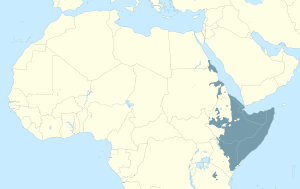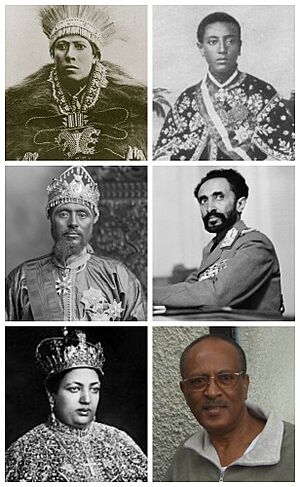Cushitic languages facts for kids
Quick facts for kids Cushitic |
|
|---|---|
| Geographic distribution: |
Egypt, Sudan, Horn of Africa, East Africa |
| Linguistic classification: | Afro-Asiatic
|
| Proto-language: | Proto-Cushitic |
| Subdivisions: |
North Cushitic (Beja)
Agaw languages (Central)
Highland East Cushitic (Sidamic)
South Cushitic
|
| ISO 639-2 and 639-5: | cus |
 Distribution of the Cushitic languages in Africa
|
|
 Map of the Cushitic languages
|
|
The Cushitic languages are a group of languages. They are part of the larger Afroasiatic language family. People mainly speak these languages in the Horn of Africa. This area includes countries like Ethiopia, Somalia, and Eritrea. You can also find speakers in parts of the Nile Valley and East Africa.
Some of the most widely spoken Cushitic languages are Oromo and Somali. Others include Beja, Agaw, Afar, Saho, and Sidamo. Millions of people use these languages every day.
Contents
What are Cushitic Languages?
Cushitic languages are a branch of the Afroasiatic family. This family includes many languages spoken across Africa and the Middle East. Think of it like a big tree with many branches. The Cushitic languages are one of those main branches.
Where are They Spoken?
These languages are mostly spoken in Northeast Africa. This region is often called the Horn of Africa. It includes countries such as:
Important Cushitic Languages
Many Cushitic languages are spoken by large groups of people.
Oromo
Oromo is spoken by over 35 million people. Most speakers live in Ethiopia. It is one of the most widely spoken languages in the Cushitic family.
Somali
Somali is the official language of Somalia. It is also spoken in Djibouti and parts of Ethiopia and Kenya. About 20 million people speak Somali.
Afar
Afar is spoken by the Afar people. They live in Ethiopia, Eritrea, and Djibouti. It's an important language in the region.
Beja
Beja is spoken by the Beja people. They live in Sudan, Eritrea, and Egypt. It is a unique Cushitic language.
History of Cushitic Languages
The Cushitic languages have a long history. They developed over thousands of years. Experts study how these languages are related. They look for common words and grammar rules. This helps them understand ancient connections between different groups of people.
Why are They Important?
These languages are important for many reasons. They carry the history and culture of the people who speak them. They are used in daily life, education, and media. Learning about them helps us understand the rich diversity of human communication.
See also
 In Spanish: Lenguas cushitas para niños
In Spanish: Lenguas cushitas para niños


